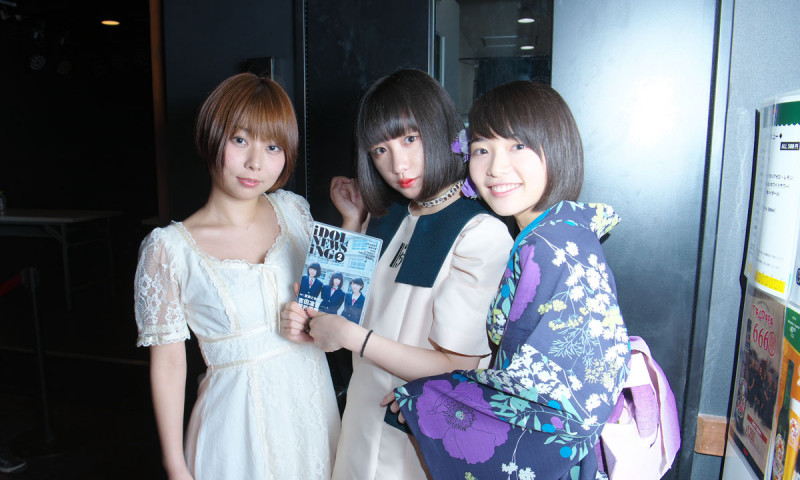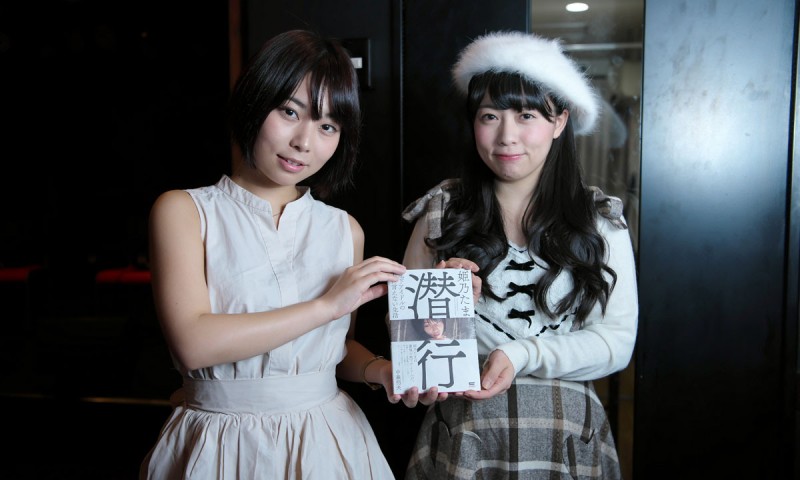
Bookdol Union #8: Featuring Idol DVD Magazine IDOL NEWSING vol.2


Sponsored Links
For our readers abroad reading this article, you may have heard what is known as an “Underground Idol” before, but I think many of you have not actually seen one in person. This is the same apart from the idol culture, and applies to most Japanese people as well. What is an “Underground Idol”? Until now, you had to go to the scene itself to find out. .
この記事を読んでいる海外の読者のなかには「地下アイドル」と呼ばれる存在を聞いたことはあっても、直接目にしたことがない人も多いかもしれない。それは、アイドル文化に関わりのない、多くの日本人も同様だ。「地下アイドル」とは何者か。そのことを知るためには、これまで実際に現場に行かなくてはならなかったのだ。
However, there is now a book that honestly talks about the reality of “underground idols”, and it’s becoming a hot topic both within and outside of Japan’s subculture world. The book is by Tama Himeno, and is called “Senkou Chika Aidoru no Hito ni Ienai Seikatsu”, (or Incognito: The Lifestyle You Can’t Talk About to Underground Idols) [Saizo Magazine]. In the book, the author, who, since debuting as an “underground idol” at the age of 16, cleverly writes about her sharp investigations regarding the lifestyles she has seen and heard other “underground idols” live, as well as the subculture around it.
だがそんな「地下アイドル」の実態を赤裸々に綴った一冊の本がいま、日本のサブカルチャー内外で大きな話題を呼んでいる。姫乃たま『潜行 地下アイドルの人に言えない生活』(サイゾー)だ。本書には、16歳でデビューして以来、「地下アイドル」として活動をし続けている彼女が実際に見聞きした「地下アイドル」の生活や、その周辺の文化についてのとても鋭利な考察が、巧みな文章で記されている。
Tama Himeno’s reason for debuting is rather trivial. She was invited into the “underground idol” world when, as a first year in high school, she went to an event out of curiosity, and became close with an older “underground girl”. For a while after that, her life became a repetition of performing live performances at small venues, whenever school was over. Tama Himeno says that, in this way, it is almost like an after-school club, in that it is extremely easy to end up starting the life of an “underground idol”.
姫乃たまのデビューのきっかけは些細なものだ。彼女は高校1年生の時に興味本位で見に行ったイベントで、「地下アイドル」のお姉さんと仲良くなり、その世界に誘われた。それからしばらくすると、学校が終われば小さな会場でライブをするという生活を繰り返すこととなる。「地下アイドル」とは、このように、まるで部活動みたいに簡単に始められてしまうものだと、姫乃たまは言う。
However, even if the entrance is there and open for anybody, it does not mean the path is a smooth one. Inside her book, Tama Himeno writes again and again about her own hardships she experienced as an “underground idol” as she moved up. Although she may have begun her debut nonchalantly, before she was aware of it, she found herself in a “deep ocean” surrounded by darkness, where she had to swim around all by herself.
しかし、入り口こそ誰にでも開かれているものの、決してその道は歩きやすく舗装されているわけではない。姫乃たまは本書のなかで、自身が「地下アイドル」としてステップアップしていくうちに体験した苦難の数々を書き綴る。何気なくデビューした彼女はいつのまにか、闇に覆われた「深海」をひとりで泳がざるを得なくなってしまったのだった。
The “deep ocean” of “underground idols” is eternally deep. Among the girls in the darkness, there are some that have become so lost, they can’t get themselves out. In her book, Tama Himeno writes, without covering up any of the facts, about the truth she heard herself from the “underground idols”, with each and every one of their experiences a story of how deep the “underground idol” culture is. Even so, in the midst of this darkness, if these “underground idols” can stand on the stage and be showered in the spotlight, they find themselves, at once, beginning to shine. For these girls, this is the only place where they “belong”.
「地下アイドル」の「深海」は果てしなく深い。彼女たちのなかには、暗闇に迷い込んで抜け出せなくなってしまった人々がいる。本書には姫乃たまが直接見聞した彼女たちの真実が粉飾ない形で綴られていて、そのエピソードのひとつひとつが「地下アイドル」という文化の奥深さを物語っている。けれど、そんな暗闇のなかでもがく「地下アイドル」たちもステージに立ってスポットライトを浴びれば、たちまち輝きを放ち始める。彼女たちにとってそこが唯一の「居場所」なのだ。
What fixates these girls on the way of life that is an “underground idol”? At the same time, what causes the wild enthusiasm among their fans? Tama Himeno, with her first-class observing eye, sees it as both the underground idols’ “desire for acknowledgement” and “the fans’ desire for recognition” working together, creating a situation like mirrors facing each other, creating a loop.
なにが彼女たちを「地下アイドル」というあり方に執着させ、同時にファンたちを熱狂させるのか。姫乃たまはその一流の観察眼で、そこに「地下アイドルの承認欲求」と「ファンの認知欲求」が相互に作用し、「合わせ鏡のようにループ」している状況を見て取る。
“Underground idols” have the desire to be “seen, cheered on, and acknowledged”. On the other hand, fans also have the desire to be remembered and acknowledged by the idols themselves. Idols resu, or respond, to this desire in the form of communication; either by focusing on one particular fan during a performance and pointing or winking at them, replying to them on Twitter, or taking polaroid photos with them after the performance is over. In return, the satisfied fan will support that idol more and more, and recognize their worth. This cycle gradually accelerates, and continues semi-permanently. This is, according to Tama Himeno’s analysis, the framework that supports this generation’s “underground idol” culture.
「地下アイドル」たちには「見られたい、応援されたい、認められたい」という欲望がある。一方で、ファンたちにはアイドルに自分のことを覚えてもらいたい、認知してもらいたいという欲求がある。アイドルはファンのその欲求を「レス」(ライブ中にファンのひとりに対して指をさしたりウインクしたりすること)や、Twitterでのリプライ、それから、ライブ終演後のチェキの撮影時におけるコミュニケーションを通じて満たしていく。すると、欲求を満たされたファンはますますそのアイドルを応援し、その価値を承認していく。この循環は次第に加速し、半永久的に続いていく。これが現代の「地下アイドル」の文化を支えている仕組みだと、姫乃たまは分析する。
This is a clever analysis from Tama Himeno. As she clearly points out, our generation is one that, from the very beginning, feels uneasy about recognition. Especially now, many young people are going around, conflicted, thinking about how they can be acknowledged. Under the chain of communication on SNS, sure enough people’s concern, regarding whether they are being acknowledged or not, is growing. “Underground idols” were born and raised in this generation of uncertainty around recognition.
この姫乃たまの分析は鋭い。よく指摘されるように、そもそも、現代とは承認不安の時代である。いまや多くの若い人たちは、どうやって自己を承認してもらうかを巡って葛藤している。SNS上でのコミュニケーションの連鎖のなかで、果たして自分は認めてもらえるのだろうかという不安が増幅していくのだ。「地下アイドル」たちはその承認不安の時代のなかで生まれ育ってきた。
Just as the sociologist Shinji Miyadai says, people in large communities who do not find their worth recognized, will find another world that affirms their self-worth, as a replacement. In the SNS world, there is the “love” and “like” buttons to serve this very purpose: to allow these people to gain acknowledgment.
社会学者の宮台真司が言うように、大きな共同体にとっての価値を承認してもらえない人々は、代わりとなる世界をどこかに探して自己価値を肯定してもらうことを求める。SNSに必ずある「お気に入り」や「いいね!」の機能はまさに、そんな彼・彼女らの自己承認を得るためのツールとして実によく役立っている。
Let’s return to the topic of “Underground Idols”. The “underground idols” who live in this world of uncertain recognition have their self-worth reaffirmed when people continue to support them (and of course always follow them back on SNS). At the same time, the fans can continue to guarantee the existence of the place where they belong by being acknowledged. These relationships feed each other, creating an endless loop. In this way, the phenomenon known as “underground idols” continues to expand within itself.
話を「地下アイドル」に戻そう。承認不安の時代に生きる「地下アイドル」たちは、彼女らを応援し続ける(そしてSNSなどで必ずファボしてくれる)ファンたちによってその自己価値を肯定されている。ファンたちもまた、認知されることで自分の居場所を確保し続ける。この関係がお互いを高め合い、終わることのないループを作り出す。こうして「地下アイドル」現象はその内部で膨張し続けていく。
Even so, why is this book about “underground idols” considered “literary”? No reader will find themselves bored, as the author reflects about “underground idols” and objectively grasps the social phenomenon, to the very end.
それにしても「地下アイドル」について綴られた本書はなんて「文学的」なのだろうか。モノローグの文体で「地下アイドル」としての自己の内面を省察しながら、あくまで客観的にその社会現象を捉える手さばきは、読者を飽きさせることがない。
Tama Himeno says the idol boom will not end as long as people have uneasiness in their hearts. The “underground idol” culture is deeply rooted in the spirits of Japanese people today, and is both “endless and unusual”.
姫乃たまは言う。アイドルブームは人々の心が不安な限り終わることはない、と。「地下アイドル」という文化は、現代の日本人の精神に深く根ざした「終わりなき非日常」なのである。
Related link
Tama Himeno Official site : http://himeeeno.wix.com/tama
Buy Item
Translated by Tanoshii Emily
Sponsored Links

[Exclusive Program] Tokyo GIrls’ Update TV #006 : SBY in Shibuya109 & Pikarin’s Cosplay

8th Wave of Tokyo Idol Festival 2016 Performers Announced!!



